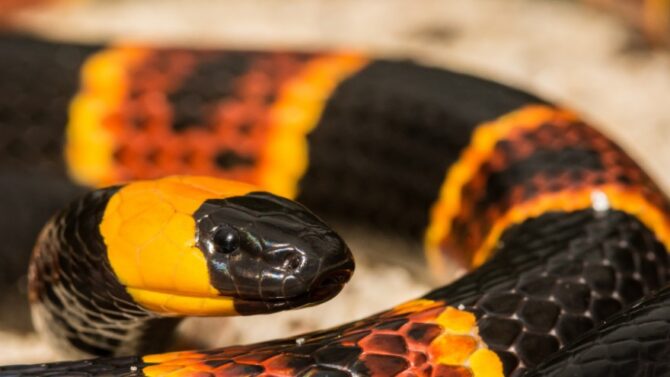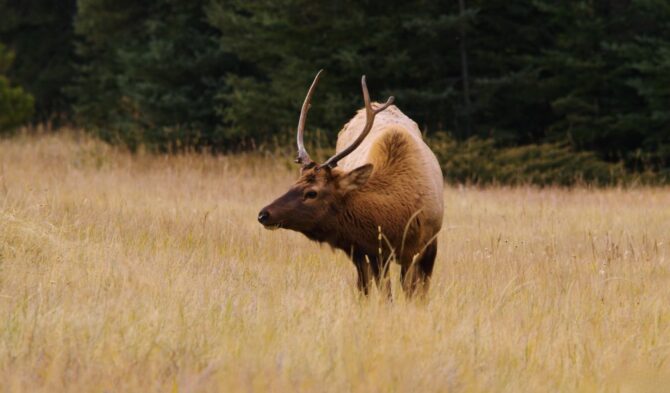Texas, a state in the South Central region of the United States, is home to diverse wildlife.
This includes large predators, like wolves and ocelots, and rodents, like squirrels and porcupines.
Among this array of wildlife are over 115 species of snakes, a few of which are venomous.
While these venomous snakes play a major ecological role as predators of insects and animals, many Texans still view them as dangerous and scary.
All venomous snakes in Texas are categorized into four groups: copperheads, cottonmouths, rattlesnakes, and coral snakes.
In this article, we’ll explore each of these groups of venomous snakes and how you can identify them and their habitat anywhere in Texas.
4 Venomous Snakes in Texas
1. Copperheads

- Scientific Name: Agkistrodon contortrix
- Size: 24 to 36 inches
- Habitat: Mixed pasture, rocky areas, wooded lowlands, and near streams and other waterways
- Identifying Features: Vertical pupils, triangular heads, head wider than the neck, a pit between the eyes and nostrils
- Behavior: Secretive or shy, loud hissing, flattens its body, violent movement, sweeps about when disturbed
- Threats: Rarely fatal venom, warning or dry bite, severe pain and nausea, tingling sensation, throbbing, and swelling
Copperheads belong to a subfamily of venomous snakes called pit vipers.
There are three subspecies of copperheads commonly in Texas:1
- The southern copperhead (A.c. contortrix)—the most common subspecies of copperhead in Texas, which spans 20 to 30 inches long and is found in the eastern one-third of Texas
- The broad-banded copperhead (A.c. laticinctus), spanning about 24 inches long and scattered across central and western Texas
- The Trans-Pecos copperhead (A.c. pictigaster), which spans 20-30 inches long and is found near springs in the southern part of the Trans-Pecos.
The skin colors of copperheads may vary based on the subspecies.
However, their skin pattern typically consists of noticeable dark brown hourglass-shaped markings, set against a backdrop of light reddish brown.
In Texas, copperheads are mostly found in rocky lands and wooded lowlands. Hardly will you find them in desert areas.
They feed mostly on small vertebrates and invertebrates, including arthropods, frogs, insects, mice, and other snakes.
They are also excellent at camouflage.
Usually, copperheads stay still even when approached closely and only bite when touched.
Other defensive mechanisms copperheads display include vibrating their tails, especially when closely approached.
They can vibrate their tails more than 40 times per second, which is way faster than any non-rattlesnake can.
Copperheads are not aggressive, and their bites are rarely fatal.
They usually employ what is known as a warning or dry bite when stepped on. This is simply a bite that doesn’t inject venom into the victim.
Symptoms of the venom of a copperhead include severe pain and nausea, a tingling sensation, throbbing, swelling, and death.
2. Cottonmouths
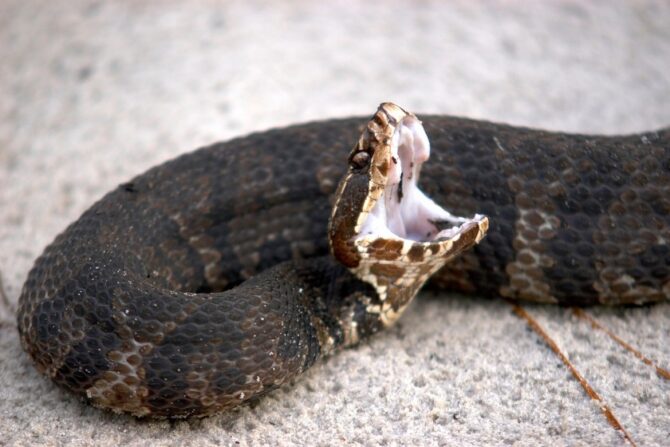
- Scientific Name: Agkistrodon piscivorus
- Size: 30 to 42 inches
- Habitat: Damp areas like streams, lakes, swamps, ponds, and roadside drainage.
- Identifying Features: Cat-like pupils, dark olive-brown or even black skin color, thick body, bright white mouth like cotton, mostly plain or with patterns
- Behavior: Violent flight, rapid crawling, raising head and neck, expanding jaw, vibrating tail, flickering of the tongue, striking forward and crouching
- Threats: Deadly bite, huge swelling, severe pain, tissue damage, loss of arms, penetration of bloodstream with fangs, and death
Cottonmouths, also known as water moccasins, are another species of pit viper in the subfamily Crotalinae of the family Viperidae.
They are very large and can inflict painful and fatal bites at maturity.
Cottonmouths are mostly found in or near slow-moving water bodies, like shallow lakes, streams, and marshes.
The scientific name of cottonmouths includes the epithet “piscivorus,” which refers to their main prey: fish.2
Likewise, their other common name, water moccasin, suggests their classification as aquatic animals, as they can swim well.
These snakes display some self-defense mechanisms in the face of danger.
These include coiling their bodies and displaying their fangs, vibrating their tails, and throwing their head back with their mouth open to display their glaringly white interiors while often hissing loudly.
In extreme cases, cottonmouths flatten their bodies and emit a pungent secretion from the anal gland at the base of their tail.
The venomous bites of cottonmouth are highly dangerous.
Their venom contains enzymes that cause the total destruction of the body tissues of the victim.
Although their bite isn’t always lethal, it causes several symptoms, including severe pain, numbness, shortness of breath, impaired vision, increased heart rate, nausea, ecchymosis (bruise) and edema (swelling), severe bleeding, and damage to the body tissues.
If untreated, the victim may die eventually.
3. Rattlesnakes
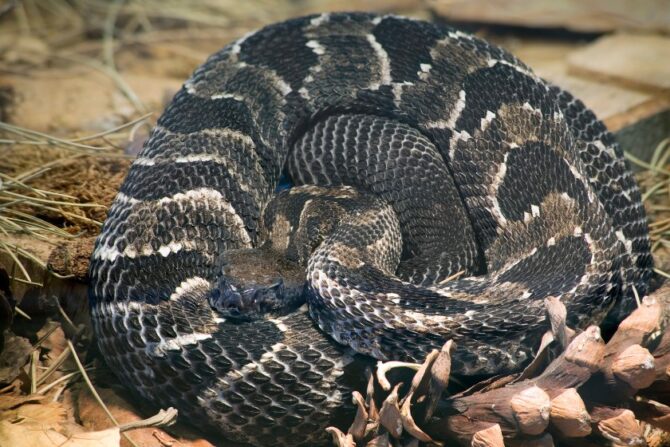
- Scientific Name: Crotalus sistrurus
- Size: 36 to 40 inches
- Habitat: Deciduous hardwood forest, rugged terrain, lowlands, wetlands, dens, and residential areas
- Identifying Features: Large, heavy bodies, large black stripes like crossbands, reddish-brown stripes, pinkish-gray color, black tails
- Behavior: Solitary, uses camouflage, hibernates in dens during winter, relates with copperheads and black rats snakes, roams at night (especially during summer)
- Threats: Not very aggressive but can give dangerous bite which results in severe pain, constant bleeding, swelling, blurred vision, tissue necrosis, skin darkening, cell death, paralysis, and cardiac arrest
Rattlesnakes are known for their heavy bodies and diamond-shaped heads.
They got their name from the rattle at the end of their tail, which makes a loud rattling noise when it vibrates.
Their rattle is made up of keratin, the same material found in human hair and fingernails.
Vibrating it serves as a deterrent to predators or a warning to passers-by.
There are about 36 known species of rattlesnakes and between 65 and 70 subspecies, all native to America.
Two of these species can be found in Texas: timber rattlesnakes (Crotalus horridus) and Mojave rattlesnakes (Crotalus scutulatus).
Rattlesnakes are leading contributors to the injuries and deaths of snakebite victims in Texas.
Symptoms of their bite include redness, swelling, bruise, bleeding or blistering, severe pain and tenderness at the site of the bite, nausea, vomiting or diarrhea, difficulty in breathing, and death.
Other symptoms include paralysis, bleeding disorder, fatal hemorrhage, irreversible kidney failure, blurry vision, low blood pressure, discoloration of the skin, permanent disability (usually blindness), and limb amputation.
4. Coral Snakes
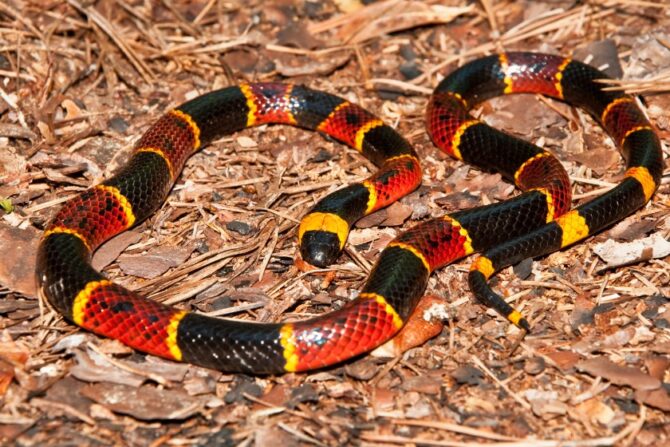
- Scientific Name: Micrurus tener
- Size: 24 to 48 inches
- Habitat: Hardwood, flat woods, logs of wood, pine, litters of leaves, and rotten wood
- Identifying Features: Slender, small head, round pupils, wide black and red rings, a narrow yellow ring.
- Behavior: Not aggressive, flees confrontation, hides under litters of leaves or on rotten wood.
- Threats: Nausea, vomiting, double vision, abnormal sensation, weakness, dropping eyes, paralysis, respiratory system failure, death.
Coral snakes are a large group of brightly colored venomous elapid snakes.
It is slender with a small indistinctive head and round pupils.
They are most notable for their red, yellow/white, and black color blend.
Coral snakes are not generally aggressive and will likely flee any confrontation.
They are shy, secretive, elusive, and burrowing. They are mostly active at night and dormant during the day.
Coral snakes are the most venomous snake species in Texas.
Their fangs are positioned at the front of their mouths and are small and inefficient, so rather than bite quickly and let go (like vipers), they hold onto their prey and make chewing motions when biting.
Additionally, their venom contains a powerful neurotoxin that causes neuromuscular dysfunction.
Symptoms of their venom include severe pain and paralysis of the breathing muscles, which can cause respiratory failure and death if left untreated.
Conclusion
All four groups of venomous snakes in Texas should be treated cautiously.
Though some of these snakes aren’t aggressive, their venom contains toxins that can be lethal.
As these venomous snakes are scary and dangerous, you may feel tempted to kill them when you encounter them.
However, many snakes in Texas are protected by state law.
Therefore, it is unlawful to indiscriminately kill, poach, or use any control measure for them.
Before capturing any of them for research purposes, using any snake control measures, or moving them to another area, it’s advisable to always contact the local representative of the Texas Parks & Wildlife Department.
References & Notes
- Venomous Snake Safety. Texas Parks & Wildlife Department
- Western Cottonmouth (A Guide to the Snakes of Southeast Texas). iNaturalist
